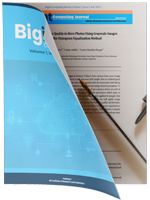Visualization of the Distribution of Formal and Non-Formal School Locations in Asahan Regency Based on GIS
DOI:
https://doi.org/10.55537/bigint.v3i2.1250Keywords:
Geographic Information System, School Mapping, Formal Education, Non-Formal EducationAbstract
Equal access to education remains a key challenge in the development of human resources at the regional level. Asahan Regency is home to a variety of formal and non-formal educational institutions spread across multiple districts. However, the distribution data of these institutions is still fragmented and not yet integrated into a centralized system. This study aims to map the locations of formal and non-formal schools registered under the Department of Investment and One-Stop Integrated Services (DPMPTSP) in Asahan Regency using Geographic Information System (GIS) technology. The developed system presents spatial information through an interactive digital map that helps the public locate schools according to their needs and supports the local government in planning equitable distribution of educational facilities. In addition, the system includes a feature that allows school administrators to upload administrative documents digitally, thereby streamlining the registration process at the Public Service Mall. The research employs a descriptive qualitative approach with data collection techniques such as observation, documentation, and interviews. The results show that GIS implementation effectively provides accurate visualizations of school distribution patterns and helps identify areas lacking in educational facilities. The system also enhances the efficiency of the administrative process for school licensing.
Downloads
References
A. S. M. Mz, “Peranan tabligh sebagai sarana dalam meningkatkan kemampuan public speaking di Pesantren Al Mukhtariyah Sungai Dua Kecamatan Portibi,” Jurnal Khabar: Komunikasi dan Penyiaran Islam, vol. 7, no. 1, pp. 183–198, 2025.
R. Dian, M. Maghfirah, R. Delianggi, and A. Pratama, “Mapping and development of railway station websites in West Sumatra Province using QGIS and GitHub,” Jurnal IPTEK Bagi Masyarakat, vol. 4, no. 1, pp. 39–49, 2024, doi: 10.55537/jibm.v4i1.909.
A. J. N. Al’basit, P. S. Tara, and M. R. Gutawa, “Sistem informasi geografis pemetaan Sekolah Menengah Atas di Kota Baturaja menggunakan aplikasi Google Maps,” Jurnal Informatics and Business, vol. 2, no. 3, pp. 515–518, 2024.
C. Teresia, P. Purwanto, and W. Wijiyono, “Implementasi pembelajaran geografi berbasis teknologi melalui pembuatan peta digital dengan Microsoft Excel untuk meningkatkan keterampilan spasial siswa kelas X SMA Negeri 1 Gondanglegi,” Geography: Jurnal Kajian, Penelitian dan Pengembangan Pendidikan, vol. 13, no. 1, pp. 74–87, 2025.
A. Anggina, H. F. Siregar, and Y. H. Siregar, “Design of web-based social aid data management information system in Sei Kera Hulu Village,” Jurnal IPTEK Bagi Masyarakat, vol. 3, no. 3, pp. 107–119, 2024, doi: 10.55537/jibm.v3i2.802.
N. Wijaya, “Strategi pengelolaan Badan Usaha Milik Desa (BUMDes) dalam meningkatkan pendapatan asli desa: Studi kasus Desa Bojonggede Kecamatan Bojonggede Kabupaten Bogor,” Jurnal Wahana Bina Pemerintahan, vol. 5, no. 1, pp. 42–56, 2023.
N. Nurhayati, L. S. P. Lubis, D. Kusyani, and A. Arianto, “Kepemimpinan kepala sekolah dalam menerapkan pendidikan karakter murid,” Pedagogi: Jurnal Ilmiah Pendidikan, vol. 8, no. 2, pp. 116–122, 2022.
N. L. Ibrahim, “Analisis literatur penggunaan model Rasch untuk validasi instrumen asesmen pendidikan: Tren, temuan, dan implikasi,” Lencana: Jurnal Inovasi Ilmu Pendidikan, vol. 3, no. 2, pp. 46–60, 2025.
P. Utomo, N. Asvio, and F. Prayogi, Metode Penelitian Tindakan Kelas (PTK): Panduan Praktis untuk Guru dan Mahasiswa di Institusi Pendidikan, Pubmedia Jurnal Penelitian Tindakan Kelas Indonesia, vol. 1, no. 4, p. 19, 2024.
N. Salsabilla and H. F. Siregar, “Decision support system for the selection of new members of Himprosi using the SAW method,” Sistem Pendukung Keputusan dengan Aplikasi, vol. 3, no. 1, pp. 13–24, 2024, doi: 10.55537/spk.v3i1.752.
A. P. Sari and S. Supiyandi, “Decision support system for sub-district election committee recruitment using the additive ratio assessment method,” Sistem Pendukung Keputusan dengan Aplikasi, vol. 3, no. 2, pp. 88–99, 2024, doi: 10.55537/spk.v3i2.789.
D. Satria, “Sistem informasi geografis penempatan fasilitas publik Pemerintah Kota Banda Aceh berbasis Google Maps API,” Jurnal Teknologi Informasi, vol. 2, no. 1, pp. 60–67, 2023.
L. Astuti, H. Syafwan, and A. Nasution, “Sistem informasi geografis untuk pemetaan lokasi rumah Tahfidz Qur’an,” Edumatic: Jurnal Pendidikan Informatika, vol. 6, no. 2, pp. 234–241, 2022.
F. Abdurrohman and A. W. Utami, “Rancang bangun aplikasi pemetaan tenaga kerja berbasis web sistem informasi geografis pada Disnakertrans Jawa Timur: Studi kasus bidang penempatan dan pelatihan kerja,” Jurnal Emerging Information Systems and Business Intelligence, vol. 4, no. 2, pp. 33–41, 2023.
B. Chen, H. Zhang, C. U. I. Wong, X. Chen, F. Li, X. Wei, and J. Shen, “Research on the spatial distribution characteristics and influencing factors of educational facilities based on POI data: A case study of the Guangdong–Hong Kong–Macao Greater Bay Area,” ISPRS International Journal of Geo-Information, vol. 13, no. 7, p. 225, 2024.
Downloads
Published
How to Cite
Issue
Section
License
Copyright (c) 2025 Sarmila Sarmila, Novica Irawati, Afdhal Syafnur

This work is licensed under a Creative Commons Attribution-ShareAlike 4.0 International License.



